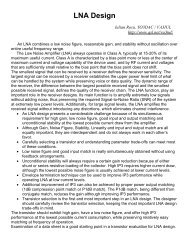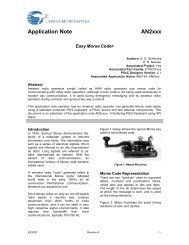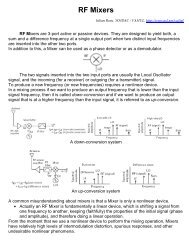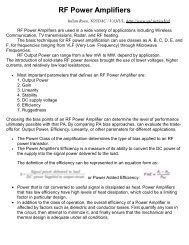balanced amplification technique using Wilkinson and 90 degrees
balanced amplification technique using Wilkinson and 90 degrees
balanced amplification technique using Wilkinson and 90 degrees
You also want an ePaper? Increase the reach of your titles
YUMPU automatically turns print PDFs into web optimized ePapers that Google loves.
LNA<br />
Article 1 (<strong>Wilkinson</strong>)<br />
An ideal <strong>balanced</strong> configuration provides low input <strong>and</strong> output VSWR in addition to a 3 dB<br />
improvement of the power <strong>and</strong> linearity performance.<br />
The Traveling-Wave Divider/Combiner(1) is a planar structure used to increase output power<br />
by combining parallel amplifier stages. The simplest implementation is a 2-way <strong>Wilkinson</strong> type<br />
divider/combiner with a <strong>90</strong>transmission line in one arm. The <strong>Wilkinson</strong> divider provides an<br />
equal-power, equal-phase power split <strong>and</strong> the transmission line shifts the phase of one path<br />
by <strong>90</strong>° so at the output of the divider we have two equal power signals in quadrature (phase<br />
shifted by <strong>90</strong>°) as shown in Figure 1. Two identical power amplifiers with gain A are placed in<br />
each arm. Any reflected power at the input to the amplifier is terminated in the 100-isolation<br />
resistor, since the reflected power of the two arms at the resistor is 180° out of phase. A<br />
combiner with similar properties is placed at the output to combine both output signals from<br />
the amplifiers, but the extra <strong>90</strong>° line is placed in the opposite arm so that the output signals<br />
add in phase through the combiner. Assuming no loss <strong>and</strong> perfect combining, the 2-way<br />
combiner will increase output power <strong>and</strong> linearity by 3 dB. Given a real life application, the<br />
typical increase is 2.5 dB. Even though this power combiner is comprised of multiple quarterwave<br />
lines, the <strong>Wilkinson</strong> type divider/combiner with a <strong>90</strong>° transmission line has a broad<br />
b<strong>and</strong>width, significantly wider than a branch-line type combiner, <strong>and</strong> has low loss. Since the<br />
combiner is planar, it is much easier to fabricate <strong>using</strong> st<strong>and</strong>ard PCB technology. The<br />
example we show in Figure 1 has a 50-impedance at the amplifier input.<br />
However, lower impedances can be achieved by increasing the transformation ratio in the<br />
quarter wave lines. Unlike branch line or Lange type combiners, the <strong>Wilkinson</strong> type<br />
divider/combiner easily scales to 4-way combining for even higher power. The performance of<br />
the <strong>balanced</strong> stage is 2.5 dB to 2.8 dB better than performance of a single-ended unit under<br />
the same conditions. This novel design approach for combining two power amplifiers offers<br />
simple low-cost implementation, wide b<strong>and</strong>width (approximately 40% versus 15% for a<br />
branch-line approach).
Article 2 (<strong>90</strong>deg)<br />
The absence of S-parameter information in low temperatures precluded the design of a<br />
feedback amplifier, so a <strong>balanced</strong> configuration was adopted. This has the advantage of<br />
providing a good input match even though the amplifiers in the two arms of the <strong>balanced</strong><br />
circuit are poorly matched. However, there are disadvantages. The loss of the input hybrid<br />
degrades the noise temperature <strong>and</strong> coupling errors in the hybrids, <strong>and</strong> differences between<br />
the amplifiers reduce the gain <strong>and</strong> result in a noise contribution from the input load.<br />
Article 3 (Narda <strong>90</strong>° Hybrids)<br />
A <strong>90</strong>° Hybrid (Hybrid Junction) is a network having the<br />
electrical characteristics of a 3 dB directional coupler<br />
whose branch line is not terminated. The four terminal network<br />
can be considered to have two pairs of terminals<br />
called conjugate pairs. In most packages, each conjugate<br />
pair is located on either side of the device (Figure 1). The<br />
two terminals that make up the conjugate pair are isolated<br />
from each other. Therefore, power flowing into one terminal<br />
of the pair does not appear at its conjugate, but is<br />
equally divided between the terminals of the opposite conjugate<br />
pair. When used as a power divider, any one of the<br />
four terminals can be used as the input. With the conjugate<br />
port of the input terminated in 50 ohms, the two outputs<br />
at the opposite conjugate pair will be of equal<br />
amplitude <strong>and</strong> in quadrature (<strong>90</strong>° apart in phase).<br />
The primary advantage of the hybrid junction is its power<br />
h<strong>and</strong>ling capability. Since the isolated port (conjugate of<br />
the input port) is terminated externally, the only limitations<br />
to power h<strong>and</strong>ling are heat generated by the internal dissipation<br />
losses <strong>and</strong> the power h<strong>and</strong>ling capability of the external<br />
termination. As stripline losses are typically low,<br />
hybrid junctions can be designed to h<strong>and</strong>le up to 500<br />
Watts average power in special versions. Another advantage<br />
of the hybrid junction is that it maintains its quadrature<br />
relationship over the full operating frequency range of<br />
the device. This characteristic is highly desirable in Polar<br />
Frequency Discrimination <strong>and</strong> Circularly Polarized antenna<br />
circuits.<br />
Article 3<br />
The <strong>90</strong>o Balanced Hybrid<br />
Coupler consists of two 50 strip lines<br />
arranged to be mutually coupled. The strip<br />
lines are made in various ways including PC<br />
board traces, copper or brass strips placed<br />
between high dielectric insulation materials.<br />
A signal applied to the Port 1 & 2 line will be<br />
coupled to Ports 3 & 4. Since the lines are<br />
electrically ¼ wavelength long the currents <strong>and</strong><br />
voltages are changed in phase between Ports<br />
1 & 2 <strong>and</strong> Ports 3 & 4. Forward loss is 3 dB<br />
plus incidental conducted losses.<br />
Note that this places Ports 1 & 3 <strong>and</strong> Ports 2<br />
& 4 at 180o in phase relationship. If a signal is<br />
applied to port 1 <strong>and</strong> Port 4 is terminated with<br />
a 50 load termination the applied power will
e equally split between Ports 2 & 3.<br />
Conversely, power applied to Ports 2 & 3 will<br />
be split between Port 1 <strong>and</strong> the termination at<br />
Port 4.<br />
With this device two transmitters can be<br />
coupled to a common antenna. All<br />
impedances will be matched <strong>and</strong> a high order<br />
of isolation is provided between the transmitter<br />
P.A. circuits, at least 30 dB for the hybrid<br />
coupler alone.<br />
The strip lines are transposed at one end to<br />
facilitate the best chassis layout for a Hybrid –<br />
Ferrite transmitter combiner. Note that the T1<br />
<strong>and</strong> T2 input connectors are on the same side<br />
of the hybrid ho<strong>using</strong>. We have also included<br />
a network at the antenna port that when<br />
properly adjusted, will produce more than 65<br />
dB of isolation between the T1 <strong>and</strong> T2 input<br />
ports.<br />
The <strong>Wilkinson</strong> Splitter employs two 70 <br />
sections of line, each ¼ wave length. Each<br />
line will produce a phase change of <strong>90</strong>o<br />
resulting in a 180o phase relationship between<br />
Ports 1 <strong>and</strong> 2. The 100 terminating resistor<br />
provides an effective match at the isolated<br />
ports <strong>and</strong> the conjunctive impedance of the<br />
two 70 lines in parallel is 50 at Port 1.<br />
<strong>Wilkinson</strong> Splitters are mostly used for dividing<br />
signal power to feed a number of devices from<br />
one source. One example (Figure 3) is an 8-<br />
way signal power divider for receiver<br />
multicoupling service. Of course, it works in<br />
reverse, to combine low power transmitters,<br />
provided that the 100 termination resistors<br />
<strong>and</strong> related heat sinks are capable of<br />
dissipating ½ of all power applied to the inputs.<br />
Insertion loss is 3 dB plus conducted circuit<br />
losses <strong>and</strong> isolation is usually 25 dB or better<br />
between ports.<br />
Article 4 (wikipedia)<br />
<strong>90</strong> deg. The phase difference between the two output ports of a hybrid coupler should be 0,<br />
<strong>90</strong>, or 180 <strong>degrees</strong> depending on the type used. However, like amplitude balance, the phase<br />
difference is sensitive to the input frequency <strong>and</strong> typically will vary a few <strong>degrees</strong>.
The phase properties of a <strong>90</strong>-degree hybrid coupler can be used to great advantage in<br />
microwave circuits. For example in a <strong>balanced</strong> microwave amplifier the two input stages are<br />
fed through a hybrid coupler. The FET device normally has a very poor match <strong>and</strong> reflects<br />
much of the incident energy. However, since the devices are essentially identical the<br />
reflection coefficients from each device are equal. The reflected voltage from the FETs are in<br />
phase at the isolated port <strong>and</strong> are 180 <strong>degrees</strong> different at the input port. Therefore, all of the<br />
reflected power from the FETs goes to the load at the isolated port <strong>and</strong> no power goes to the<br />
input port. This results in a good input match (low VSWR).<br />
<strong>Wilkinson</strong>. The <strong>Wilkinson</strong> power divider has low VSWR at all ports <strong>and</strong> high isolation<br />
between output ports. The input <strong>and</strong> output impedances at each port are designed to be<br />
equal to the characteristic impedance of the microwave system.<br />
Article 5<br />
A <strong>balanced</strong> amplifier design is defined by two amplifiers of equal gain, 1dB compression point<br />
(P1dB) <strong>and</strong> Third-Order Intercept (IP3), arranged in the configuration shown to the right. The<br />
couplers are 3 dB hybrids, where the input power is split equally between a 0°<strong>and</strong> a <strong>90</strong>° port.<br />
The unused ports are terminated in the system impedance – typically 50 Ω. Reflections from<br />
the input <strong>and</strong> output ports of the amplifiers are shunted to the unused port of each coupler,<br />
giving the entire arrangement a matched impedance.
Article 6<br />
The <strong>Wilkinson</strong> power divider<br />
At higher frequencies (above 500 Mhz) these devices are usually<br />
realized as a microstrip or stripline <strong>Wilkinson</strong> design. All<br />
Browadwave reactive power dividers are <strong>Wilkinson</strong> types. Figure<br />
5 shows a simple 2-Way <strong>Wilkinson</strong> power divider. Being a<br />
lossless reciprocal three port network, it inherits all its properties<br />
which state that this type of network cannot have all the<br />
ports simultaneously matched. To solve this an isolating resistor<br />
is placed between the two output ports, since no current<br />
flows through the resistor (there is no potential difference between<br />
the output ports), this resistor does not contribute to any<br />
resistive loss. This makes an ideal <strong>Wilkinson</strong> a 100% efficient<br />
device. This resistor also provides excellent isolation even<br />
when the device is used as a combiner. Another property of<br />
the <strong>Wilkinson</strong> divider is that it is broken down into quater wavelength<br />
(l/4) sections. This device is useful for limited b<strong>and</strong>width<br />
applications, but to achieve a wider b<strong>and</strong>width a multi<br />
section <strong>Wilkinson</strong> design is used as shown in Figure 6. As a<br />
general rule, the greater the b<strong>and</strong>width the more sections<br />
added to the design. But by doing so, makes devices become<br />
larger <strong>and</strong> more importantly lossy. These devices can be designed<br />
for octave b<strong>and</strong>widths <strong>and</strong> are sometimes cascaded to<br />
form higher order devices.
Article 7<br />
Balanced amplifier
Article 8<br />
For the distributed <strong>90</strong>-deg. hybrid, there are basically four quarter-wavelength distributed<br />
transmission lines connected in a "square" arrangement (Fig. 2). Two opposite transmission<br />
lines have an impedance of 50 Ω(assuming a characteristic impedance of 50 Ω) <strong>and</strong> the other<br />
two lines have an impedance of 35.35 Ω[(50 Ω) 0.5 ]. It is very important to get the orientation of<br />
the coupler input <strong>and</strong> isolated port correct (see ref. 2).<br />
As noted previously, there are two simple lumped-element equivalent circuits in a pi or tee<br />
arrangement. Either arrangement will work, although the choice may depend on other factors:<br />
for example, MMIC inductors tend to have more loss than MMIC capacitors. By choosing the<br />
pi arrangement to reduce the number of inductors, the lumped-element circuit of Fig. 3<br />
results. Note the combining of capacitors at the "corners" of the 35- <strong>and</strong> 50-Ω branches.<br />
The branchline or <strong>90</strong>-deg. hybrid can be used for many functions. Some of these include<br />
image-reject mixers, attenuators, phase shifters, modulators, <strong>and</strong> power combiners/dividers.<br />
This is true of both the lumped element <strong>and</strong> distributed implementations of the branchline<br />
hybrid. However, the distributed equivalent will repeat at three times the fundamental<br />
frequency. Also, the b<strong>and</strong>widths of the two implementations are different near the<br />
fundamental frequency, F 0 . The input match of the hybrid is good provided the terminations at<br />
the direct <strong>and</strong> coupled ports are nearly identical. Mismatches at the direct <strong>and</strong> coupled ports<br />
reflect to the isolated port. By adding a switch or variable resistor to the direct <strong>and</strong> coupled<br />
ports of the branchline hybrid, one can create a switched or variable attenuator <strong>using</strong> the<br />
input <strong>and</strong> isolated ports. Likewise, a switch or variable capacitor can be used to build an<br />
analog or digital phase shifter or phase modulator. In an image-reject mixer, one branchline<br />
hybrid at RF helps distinguish between the upper sideb<strong>and</strong> <strong>and</strong> the lower sideb<strong>and</strong> of the<br />
signal. An additional <strong>90</strong>-deg. hybrid at the intermediate frequency (IF) combines or cancels<br />
the two mixed signals to select just the upper or lower sideb<strong>and</strong>.<br />
The hybrid can also be used as a combiner or power splitter with the properties that the input<br />
match is good provided that the loads at the coupled <strong>and</strong> direct ports are matched. As a<br />
combiner, reflections from the coupled <strong>and</strong> direct port are absorbed by a resistor at the<br />
isolated port. The difficulty with the hybrid as a combiner/divider is controlling the impedances<br />
<strong>and</strong> lengths of the 35- <strong>and</strong> 50-Ω transmission lines to obtain an equal 3-dB split at the two<br />
ports.<br />
The <strong>Wilkinson</strong> coupler is often used as a power combiner or splitter. It divides an input signal<br />
equally between two outputs, or can be used to create unequal split or an n-port divider. In a<br />
<strong>Wilkinson</strong>, two quarter-wavelength 70.7-Ω lines—assuming a 50-Ω characteristic<br />
impedance—split the input to two output ports (Fig. 4). A 100-Ω resistor is tied between the<br />
two output ports to provide isolation in the odd-mode case. Placing this resistor can be much<br />
easier in a MMIC lumped-element layout than in a distributed layout (Fig. 5). For this<br />
example, a pi arrangement was chosen to reduce the number of lossy inductors. The input<br />
shunt capacitors combine into a single capacitor yielding two inductors, one shunt capacitor at<br />
each port, <strong>and</strong> the 100-Ω isolation resistor plus interconnect for the MMIC <strong>Wilkinson</strong>.<br />
As a splitter, the input is divided into two equal in-phase outputs, ideally at −3-dB levels from<br />
the input signal level. When fed at the outputs by two signals in phase <strong>and</strong> of comparable<br />
signal level, the <strong>Wilkinson</strong> acts as a power combiner. The major differences between <strong>using</strong> a<br />
<strong>Wilkinson</strong> as a divider/combiner versus the branchline hybrid is that the input match now<br />
depends on the match at the other two ports. However, it is much easier to get an equalphase,<br />
equal-power split, as well as wider b<strong>and</strong>width, with the <strong>Wilkinson</strong> than with a hybrid<br />
combiner.<br />
A <strong>90</strong>-deg. lumped-element MMIC hybrid coupler is a useful for a variety of designs, such as a<br />
phase modulator MMIC developed by a student in the Johns Hopkins University MMIC<br />
Design Course. 3 Students in that course learn to develop practical MMIC layouts that are then
fabricated at the TriQuint Semiconductor foundry. Those students developed several lumpedelement<br />
hybrid layouts, planned around a central substrate via shared by four capacitors <strong>and</strong><br />
four spiral inductors to make up the four transmission lines of the lumped element equivalent<br />
hybrid (Fig. 6). Using the pi arrangement for the lumped-element branches <strong>and</strong> combining the<br />
capacitors at the ends, the layout has a single capacitance value <strong>and</strong> two inductance values<br />
that can be tuned for performance. Arranging the layout allows performance trade-offs by<br />
tuning the single capacitance <strong>and</strong> the size of the two inductors. Careful use of symmetry<br />
makes it easier to tune the circuit without "breaking" the layout. A 2.1-GHz hybrid coupler<br />
fabricated on a 34 × 54 mil die is an example of the several hybrid couplers fabricated with<br />
the TriQuint process (Fig. 6). Hybrid couplers for other frequency ranges can use the same<br />
topology by changing the capacitor <strong>and</strong> two inductor values (plus interconnect).<br />
The performance of the hybrid coupler was simulated (Fig. 7) with the Advanced Design<br />
System (ADS) software from Agilent Technologies <strong>and</strong> the TriQuint TQTRX device library, as<br />
well as with EM simulation software from Sonnet Software (Liverpool, NY). Only the "core" of<br />
the hybrids were simulated <strong>and</strong> assumptions were made that the effects of the ground-signalground<br />
probe pads <strong>and</strong> off-chip wire bonds were minimal at these frequencies. Given<br />
additional time, the matches can be tuned to offset the off-chip wire bond inductance <strong>and</strong><br />
provide a better 50-Ω termination.<br />
A 7.5-GHz <strong>Wilkinson</strong> divider/combiner was also fabricated with the MMIC process. It consists<br />
of two 71-Ω transmission lines <strong>and</strong> a 100-Ω resistor to provide isolation for the coupled ports.<br />
Symmetry was used to ensure proper equal phase <strong>and</strong> equal amplitude split. The hybrid pi<br />
lumped-element equivalent was chosen for the MMIC implementation since it has the least<br />
number of lossy inductors. Capacitors on the input side can be combined resulting in one<br />
value for the two inductors <strong>and</strong> two values for the three capacitors—the first capacitor is twice<br />
the value of the other two. Optimizing the simulation is done by tuning the one inductor value<br />
<strong>and</strong> "one" or "two" capacitor values. A single shared substrate via was used for the shunt<br />
capacitor to ground connections. The <strong>Wilkinson</strong> was also computer simulated, although the<br />
ADS simulations did not include the isolation resistor in the layout because its effect was<br />
considered to be minimal. The layout for the 7.5-GHz X-b<strong>and</strong> <strong>Wilkinson</strong> looks similar to half of<br />
the hybrid coupler layout (Fig. 8). The 100-Ω isolation resistor was added to the layout along<br />
with the ground-signal-ground probe pads in the final layout <strong>using</strong> the ICED layout software.<br />
The 7.5-GHz <strong>Wilkinson</strong> measures 34 × 29 mils, <strong>and</strong> measured performance compared<br />
closely with ADS <strong>and</strong> EM simulations (Fig. 9). Various branchline hybrids from 2.1 to 8.4 GHz<br />
were all fabricated on a 34 × 54 mil MMIC tile with room to spare. The higher-frequency<br />
hybrids had some additional room for test circuits. Of course, the great advantage of MMICs<br />
over MICs is size, <strong>and</strong> a quarter wavelength on an alumina substrate (dielectric constant of<br />
9.8), for example, is almost 600 mils. If one needs to incorporate additional circuits such as<br />
switches, varactors, diodes, FETs, etc., the size, weight, <strong>and</strong> power savings of a MMIC over<br />
an MIC circuit can be substantially higher, although for small volumes, MICs still offer cost<br />
advantages compared to the high price of a MMIC wafer run.









